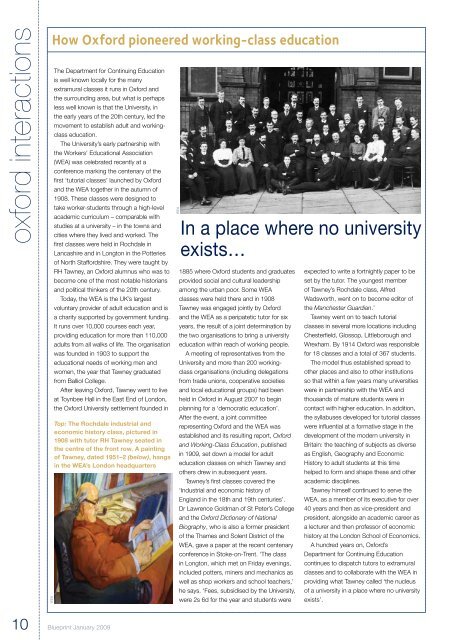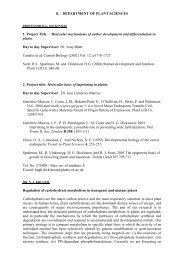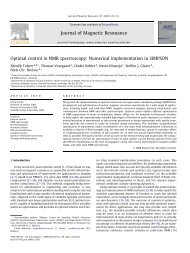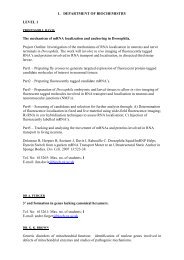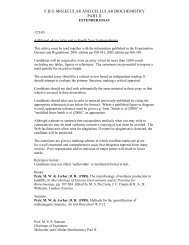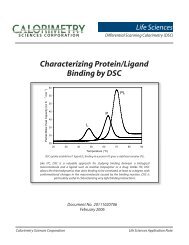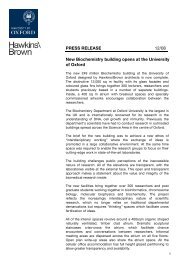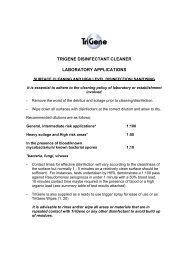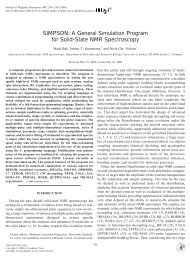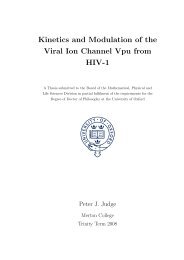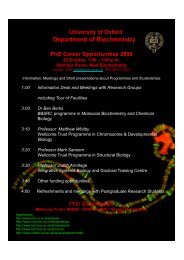Beautiful Biochemistry Educating the workers - Department of ...
Beautiful Biochemistry Educating the workers - Department of ...
Beautiful Biochemistry Educating the workers - Department of ...
You also want an ePaper? Increase the reach of your titles
YUMPU automatically turns print PDFs into web optimized ePapers that Google loves.
oxford interactions<br />
WEA<br />
How Oxford pioneered working-class education<br />
The <strong>Department</strong> for Continuing Education<br />
is well known locally for <strong>the</strong> many<br />
extramural classes it runs in Oxford and<br />
<strong>the</strong> surrounding area, but what is perhaps<br />
less well known is that <strong>the</strong> University, in<br />
<strong>the</strong> early years <strong>of</strong> <strong>the</strong> 20th century, led <strong>the</strong><br />
movement to establish adult and workingclass<br />
education.<br />
The University’s early partnership with<br />
<strong>the</strong> Workers’ Educational Association<br />
(WEA) was celebrated recently at a<br />
conference marking <strong>the</strong> centenary <strong>of</strong> <strong>the</strong><br />
first ‘tutorial classes’ launched by Oxford<br />
and <strong>the</strong> WEA toge<strong>the</strong>r in <strong>the</strong> autumn <strong>of</strong><br />
1908. These classes were designed to<br />
take worker-students through a high-level<br />
academic curriculum – comparable with<br />
studies at a university – in <strong>the</strong> towns and<br />
cities where <strong>the</strong>y lived and worked. The<br />
first classes were held in Rochdale in<br />
Lancashire and in Longton in <strong>the</strong> Potteries<br />
<strong>of</strong> North Staffordshire. They were taught by<br />
RH Tawney, an Oxford alumnus who was to<br />
become one <strong>of</strong> <strong>the</strong> most notable historians<br />
and political thinkers <strong>of</strong> <strong>the</strong> 20th century.<br />
Today, <strong>the</strong> WEA is <strong>the</strong> UK’s largest<br />
voluntary provider <strong>of</strong> adult education and is<br />
a charity supported by government funding.<br />
It runs over 10,000 courses each year,<br />
providing education for more than 110,000<br />
adults from all walks <strong>of</strong> life. The organisation<br />
was founded in 1903 to support <strong>the</strong><br />
educational needs <strong>of</strong> working men and<br />
women, <strong>the</strong> year that Tawney graduated<br />
from Balliol College.<br />
After leaving Oxford, Tawney went to live<br />
at Toynbee Hall in <strong>the</strong> East End <strong>of</strong> London,<br />
<strong>the</strong> Oxford University settlement founded in<br />
Top: The Rochdale industrial and<br />
economic history class, pictured in<br />
1908 with tutor RH Tawney seated in<br />
<strong>the</strong> centre <strong>of</strong> <strong>the</strong> front row. A painting<br />
<strong>of</strong> Tawney, dated 1951–2 (below), hangs<br />
in <strong>the</strong> WEA’s London headquarters<br />
WEA<br />
In a place where no university<br />
exists…<br />
1885 where Oxford students and graduates<br />
provided social and cultural leadership<br />
among <strong>the</strong> urban poor. Some WEA<br />
classes were held <strong>the</strong>re and in 1908<br />
Tawney was engaged jointly by Oxford<br />
and <strong>the</strong> WEA as a peripatetic tutor for six<br />
years, <strong>the</strong> result <strong>of</strong> a joint determination by<br />
<strong>the</strong> two organisations to bring a university<br />
education within reach <strong>of</strong> working people.<br />
A meeting <strong>of</strong> representatives from <strong>the</strong><br />
University and more than 200 workingclass<br />
organisations (including delegations<br />
from trade unions, cooperative societies<br />
and local educational groups) had been<br />
held in Oxford in August 2007 to begin<br />
planning for a ‘democratic education’.<br />
After <strong>the</strong> event, a joint committee<br />
representing Oxford and <strong>the</strong> WEA was<br />
established and its resulting report, Oxford<br />
and Working-Class Education, published<br />
in 1909, set down a model for adult<br />
education classes on which Tawney and<br />
o<strong>the</strong>rs drew in subsequent years.<br />
Tawney’s first classes covered <strong>the</strong><br />
‘Industrial and economic history <strong>of</strong><br />
England in <strong>the</strong> 18th and 19th centuries’.<br />
Dr Lawrence Goldman <strong>of</strong> St Peter’s College<br />
and <strong>the</strong> Oxford Dictionary <strong>of</strong> National<br />
Biography, who is also a former president<br />
<strong>of</strong> <strong>the</strong> Thames and Solent District <strong>of</strong> <strong>the</strong><br />
WEA, gave a paper at <strong>the</strong> recent centenary<br />
conference in Stoke-on-Trent. ‘The class<br />
in Longton, which met on Friday evenings,<br />
included potters, miners and mechanics as<br />
well as shop <strong>workers</strong> and school teachers,’<br />
he says. ‘Fees, subsidised by <strong>the</strong> University,<br />
were 2s 6d for <strong>the</strong> year and students were<br />
expected to write a fortnightly paper to be<br />
set by <strong>the</strong> tutor. The youngest member<br />
<strong>of</strong> Tawney’s Rochdale class, Alfred<br />
Wadsworth, went on to become editor <strong>of</strong><br />
<strong>the</strong> Manchester Guardian.’<br />
Tawney went on to teach tutorial<br />
classes in several more locations including<br />
Chesterfield, Glossop, Littleborough and<br />
Wrexham. By 1914 Oxford was responsible<br />
for 18 classes and a total <strong>of</strong> 367 students.<br />
The model thus established spread to<br />
o<strong>the</strong>r places and also to o<strong>the</strong>r institutions<br />
so that within a few years many universities<br />
were in partnership with <strong>the</strong> WEA and<br />
thousands <strong>of</strong> mature students were in<br />
contact with higher education. In addition,<br />
<strong>the</strong> syllabuses developed for tutorial classes<br />
were influential at a formative stage in <strong>the</strong><br />
development <strong>of</strong> <strong>the</strong> modern university in<br />
Britain: <strong>the</strong> teaching <strong>of</strong> subjects as diverse<br />
as English, Geography and Economic<br />
History to adult students at this time<br />
helped to form and shape <strong>the</strong>se and o<strong>the</strong>r<br />
academic disciplines.<br />
Tawney himself continued to serve <strong>the</strong><br />
WEA, as a member <strong>of</strong> its executive for over<br />
40 years and <strong>the</strong>n as vice-president and<br />
president, alongside an academic career as<br />
a lecturer and <strong>the</strong>n pr<strong>of</strong>essor <strong>of</strong> economic<br />
history at <strong>the</strong> London School <strong>of</strong> Economics.<br />
A hundred years on, Oxford’s<br />
<strong>Department</strong> for Continuing Education<br />
continues to dispatch tutors to extramural<br />
classes and to collaborate with <strong>the</strong> WEA in<br />
providing what Tawney called ‘<strong>the</strong> nucleus<br />
<strong>of</strong> a university in a place where no university<br />
exists’.<br />
10<br />
Blueprint January 2009


